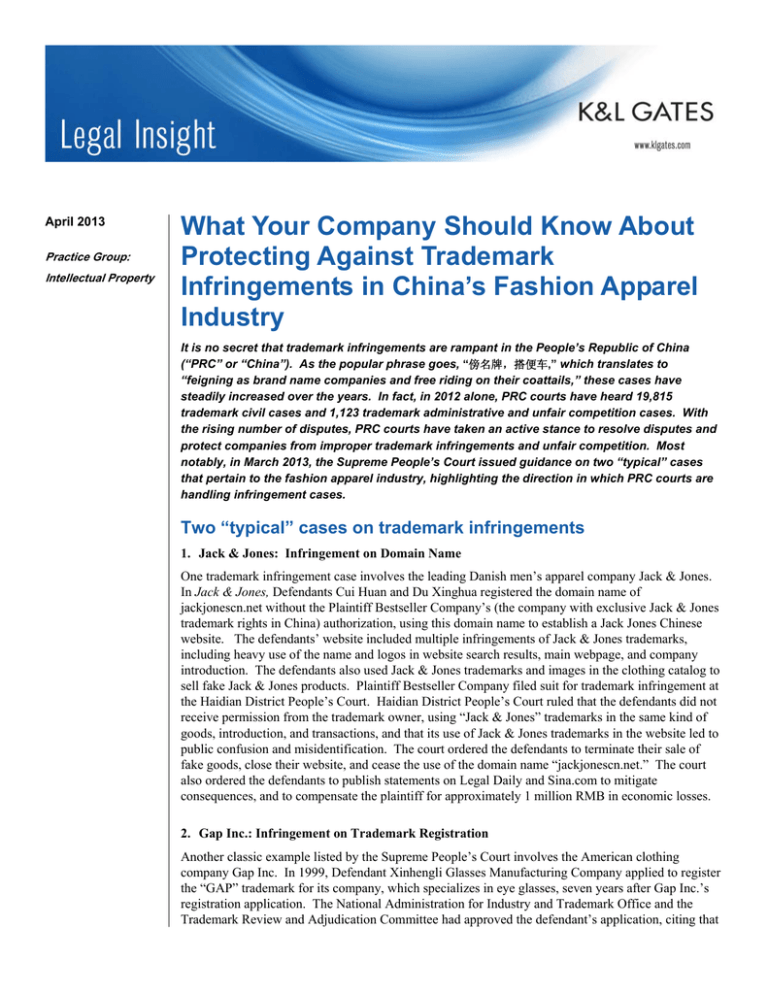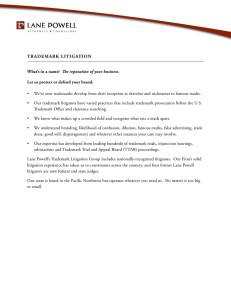
April 2013
Practice Group:
Intellectual Property
What Your Company Should Know About
Protecting Against Trademark
Infringements in China’s Fashion Apparel
Industry
It is no secret that trademark infringements are rampant in the People’s Republic of China
(“PRC” or “China”). As the popular phrase goes, “傍名牌,搭便车,” which translates to
“feigning as brand name companies and free riding on their coattails,” these cases have
steadily increased over the years. In fact, in 2012 alone, PRC courts have heard 19,815
trademark civil cases and 1,123 trademark administrative and unfair competition cases. With
the rising number of disputes, PRC courts have taken an active stance to resolve disputes and
protect companies from improper trademark infringements and unfair competition. Most
notably, in March 2013, the Supreme People’s Court issued guidance on two “typical” cases
that pertain to the fashion apparel industry, highlighting the direction in which PRC courts are
handling infringement cases.
Two “typical” cases on trademark infringements
1. Jack & Jones: Infringement on Domain Name
One trademark infringement case involves the leading Danish men’s apparel company Jack & Jones.
In Jack & Jones, Defendants Cui Huan and Du Xinghua registered the domain name of
jackjonescn.net without the Plaintiff Bestseller Company’s (the company with exclusive Jack & Jones
trademark rights in China) authorization, using this domain name to establish a Jack Jones Chinese
website. The defendants’ website included multiple infringements of Jack & Jones trademarks,
including heavy use of the name and logos in website search results, main webpage, and company
introduction. The defendants also used Jack & Jones trademarks and images in the clothing catalog to
sell fake Jack & Jones products. Plaintiff Bestseller Company filed suit for trademark infringement at
the Haidian District People’s Court. Haidian District People’s Court ruled that the defendants did not
receive permission from the trademark owner, using “Jack & Jones” trademarks in the same kind of
goods, introduction, and transactions, and that its use of Jack & Jones trademarks in the website led to
public confusion and misidentification. The court ordered the defendants to terminate their sale of
fake goods, close their website, and cease the use of the domain name “jackjonescn.net.” The court
also ordered the defendants to publish statements on Legal Daily and Sina.com to mitigate
consequences, and to compensate the plaintiff for approximately 1 million RMB in economic losses.
2. Gap Inc.: Infringement on Trademark Registration
Another classic example listed by the Supreme People’s Court involves the American clothing
company Gap Inc. In 1999, Defendant Xinhengli Glasses Manufacturing Company applied to register
the “GAP” trademark for its company, which specializes in eye glasses, seven years after Gap Inc.’s
registration application. The National Administration for Industry and Trademark Office and the
Trademark Review and Adjudication Committee had approved the defendant’s application, citing that
What Your Company Should Know About Protecting
Against Trademark Infringements in China’s Fashion
Apparel Industry
the products, uses, and services did not constitute similar goods and services as Gap Inc., and hence is
permitted to register such trademark. Plaintiff Gap Inc. appealed to both the Beijing First Intermediate
People’s Court and Beijing Municipal High People’s Court, which both upheld the Trademark Review
and Adjudication Committee’s decision to approve the opposed trademark. Gap Inc. subsequently
appealed to the Supreme People’s Court for retrial. After taking into account the evidence provided,
the Supreme People’s Court ruled in favor of Gap Inc. The court reasoned that the “GAP” trademark
had been used in China before the defendant’s trademark filing date and had gained a well-known
reputation. The defendant company also advertised that its origin is from the United States and
showcased actions that indicate intent to “free ride” on Gap Inc.’s popularity. Furthermore, the court
reasoned that while the defendant’s products (eyeglasses) fall in a different category than Gap Inc.’s
products (clothing apparel), the functional use of their products, sales channels, and consumer groups
is closely related; in fact, fashion companies commonly manage apparel, glasses, and accessories
under the same brand name. Based on the above reasons and Gap Inc.’s well-known trademark, the
court concluded that the defendant’s actions constituted use of similar trademarks on similar goods
and possessed free-riding intentions, and hence should not be permitted to register the trademark.
What do these cases mean to international apparel companies?
Both Jack & Jones and Gap Inc. represent classic trademark infringement cases in China, but are
significant in different ways. In Jack & Jones, the court emphasized the “feigning as brand name
companies” aspect of trademark infringement, particularly the defendants’ malicious intent to confuse
the public as the original Jack & Jones company, as well as the serious consequences and economic
loss caused by the defendants’ violations. In Gap Inc., the court focused on the “free riding” aspect of
trademark infringement. Most notably, the court recognized and factored in the well-known
reputation of Gap Inc. and allowed for the crossing of different product categories. This is especially
noteworthy because it indicates the court’s willingness to accept the argument that even if the
defendant’s infringing products are not in the same category as the plaintiff’s products, they may still
violate the plaintiff’s trademarks. As these two types of actions are commonly seen in PRC courts,
they serve as useful guidance if apparel companies face similar situations in trademark infringement
and registration filing in the future.
Practical Tips on Protecting Your Trademarks in China
Even though PRC courts are playing a more active role in trademark infringement cases than ever
before, companies can take several precautionary steps in protecting their trademarks.
For trademark filings:
Register your trademark as quickly as possible. Since China follows the “first to file” policy,
registering your trademark as quickly as possible is the key to protecting your IP.
Properly register your trademarks by registering multiple categories and subcategories of
goods. As a preventative measure, companies should register their trademarks in as many closely
related categories and sub-categories of goods.
2
What Your Company Should Know About Protecting
Against Trademark Infringements in China’s Fashion
Apparel Industry
For trademark infringement actions:
Vigilantly monitor infringement actions and use China’s administrative process. Companies
should use the administrative process to cease infringing products and tools, impose fines, and seek
court imposed raids if necessary.
Use court proceedings to seek damages and to obtain well-known trademark status. As
courts have become the main channel to protect IP, companies can use litigation to serve as
warnings for other violators. Companies can also seek the court’s recognition of “well-known
trademark” status in current or future cases for increased trademark protection.
The bottom line is that international apparel companies need to be vigilant in protecting their
trademarks and should seek consultation before issues arise. By taking adequate precautions in the
filing process and active measures when violations occur, international apparel companies can
continue to thrive in China’s growing fashion landscape.
Authors:
Yujing Shu
yujing.shu@klgates.com
+86.10.5817.6100
Hai-Ching Yang
hai-ching.yang@klgates.com
+86.10.5817.6102
Anchorage Austin Beijing Berlin Boston Brisbane Brussels Charleston Charlotte Chicago Dallas Doha Dubai Fort Worth Frankfurt
Harrisburg Hong Kong Houston London Los Angeles Melbourne Miami Milan Moscow Newark New York Orange County Palo Alto Paris
Perth Pittsburgh Portland Raleigh Research Triangle Park San Diego San Francisco São Paulo Seattle Seoul Shanghai Singapore Spokane
Sydney Taipei Tokyo Warsaw Washington, D.C. Wilmington
K&L Gates practices out of 48 fully integrated offices located in the United States, Asia, Australia, Europe, the
Middle East and South America and represents leading global corporations, growth and middle-market companies,
capital markets participants and entrepreneurs in every major industry group as well as public sector entities,
educational institutions, philanthropic organizations and individuals. For more information about K&L Gates or its
locations, practices and registrations, visit www.klgates.com.
This publication is for informational purposes and does not contain or convey legal advice. The information herein should not be used or relied upon in
regard to any particular facts or circumstances without first consulting a lawyer.
©2013 K&L Gates LLP. All Rights Reserved.
3


